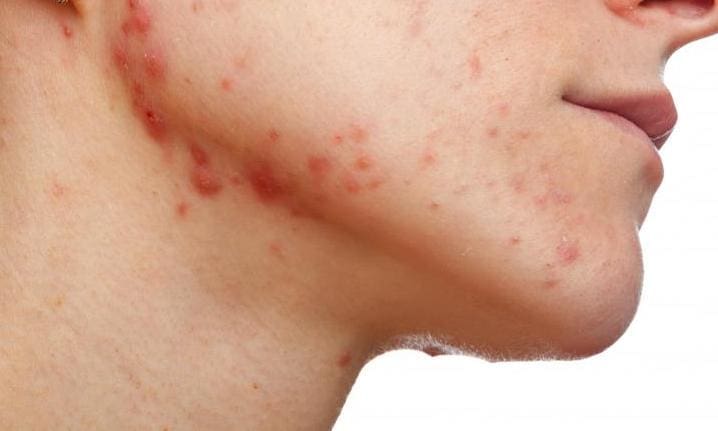
Acne which is commonly seen in teenagers, gradually disappear after adolescence. Sometimes, it may persist until adulthood and in last decade we are seeing increasing in number of people in whom acne appearing for the first time in their adulthood (occurring after 25 years of age). This is called as adult onset acne.
Acne can cause psychological disturbances and have a negative impact on the quality of life of patients, leading to decrease in self-esteem, as well as discrimination in the workplace and in other social environments.
Causes of Adult acne
Adult acne usually results from hormonal disturbances, especially cases of female hormonal acne. Sebaceous gland (oil-producing gland) which are predominantly present in our face shows increased responsiveness to androgen (male sex hormone). Androgen is not only found in men but it is also seen in women in small amounts. This leads to seborrhea (excess oil secretion) and finally gland gets blocked leading to acne. This sometimes get infected which later forms a pustule. This type of acne shows less of black or white heads compared to usual teenage acne. Almost 70% of women report worsening of the lesions during the premenstrual period.
Adult onset acne needs to be treated in all situation and must not be ignored, even in mild cases. Adult onset acne is usually resistant to treatment. It needs thorough check up to look for any signs of hyperandrogenism such as increase hair growth in beard and moustache area, androgenetic alopecia, menstrual disturbance, weight gain and deepening of the voice. In presence of such signs it is advisable to get hormonal assay done which includes total and free testosterone, dehydroepiandrosterone sulfate, follicle-stimulating hormone (FSH), luteinizing hormone (LH), prolactin (PRL) levels. Testing of fasting insulin and lipids should be advised along with ultrasound of pelvis to look for cysts in ovaries in polycystic ovary syndrome (PCOS). The best time to run laboratory tests is within the first week of the menstrual period. It is important to remember that many women with androgen excess may still have normal menstrual period.
Treatment options for Acne
Acne is a relatively common condition in women and requires medication and psychological therapy, demanding time and good adherence. Topical treatment may be enough for mild acne, but it often requires the addition of more than one cream or gel product. It is advisable to use cleansing solutions or gel cleanser to clean the face before applying the product. Benzoyl peroxide, adapalene, clindamycin and azelaic acid are some of the commonly used topical products. It is advisable to use right amount of sunscreen with minimum of SPF 30 on regular basis.
If you have a normal or dry skin, prefer a cream based sunscreen and if your skin is oily, prefer an emulsion form. Use your medicated product first and then apply sunscreen on top of it. Never squeeze the acne as it may leave behind permanent mark over your skin.
In moderate to severe cases, oral antibiotics and retinoids are used. Retinoids can cause serious birth defects in child if consumed by mother during pregnancy. Hence it should be used cautiously in women of fertile age. For women with features of hyperandrogenism can benefit from additional hormonal treatment after detailed examination. Increased hair growth can be corrected by permanent laser hair reduction or electrolysis. Regular exercise has shown to have positive effect in reducing adult onset acne in many studies.
Chemical Peel with Glycolic acid, salicylic acid or retinoic acid are efficient in all types of acne, inducing a fast improvement and restoration of normal skin. This procedure is well tolerated by most and can be done along with the above treatments.
In some patients, it results in permanently disfiguring scars. In such cases, the depressions can be filled with certain materials, and some surgical techniques can be used, such as punch excision, elevation of the scar using a punch, subcision, and cutaneous laser resurfacing. Laser resurfacing using Fractional Co2 laser and Radiofrequency are the new technologies giving good results with faster healing time.
There is a misconception in society that it regresses with adulthood; however, this is not true for many patients, especially women. Acne of low severity can persist for decades following adolescence. Timely treatment using correct medications can prevent forming of disfiguring scars. Although it is not a life-threatening disease, acne can have psychosocial implications and can impair a woman’s quality of life.
About the author: Dr Shricharith Shetty is a Consulting Dermatologist at the Kasturba Medical College & Hospital, Manipal.

Be the first to comment